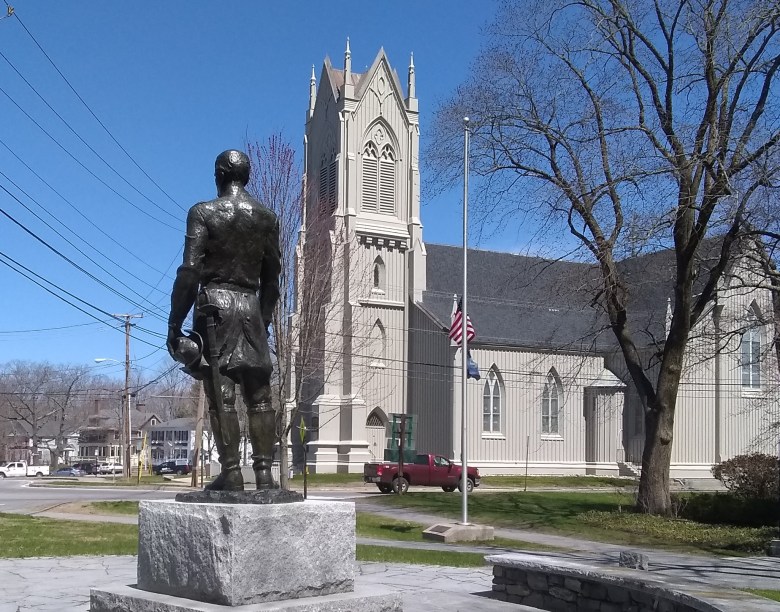Though many men have come and gone, and many buildings have been built and destroyed, one Brunswick landmark has remained a town centerpiece for 180 years. Its impressive history includes some of the most legendary names in American history.
“The First Meeting House of the First Parish Church” was originally built in 1735 and was situated about one mile south of the college, in front of the graveyard. This meeting house served the community as a place of worship and as a center of government for over 70 years.
In 1756, an additional meeting house was erected at the upper part of the New Meadows to serve the mixed community of East Brunswick. Referred to by some as the second meeting house of the First Parish, this structure was abandoned by 1834 and “carried off piece meal.”
By 1806, property was purchased from Robert Dunning and William Stanwood, and a new meeting house was built on the site of the present edifice on the hill by the college. Built by Samuel Melcher, the structure was over two stories tall, with many windows and a tall belfry tower. It was the first heated church in town, and the first bell ever rung in Brunswick was placed on this meeting house.
By February 1845, the decision was made to build a new meeting house for the First Parish Church on Maine Street. After nearly 40 years of service, the 1806 structure was torn down and the current meeting house was built in its place.
On July 10, 1845, while the new St. Paul’s Episcopal Church was being dedicated on Pleasant Street, construction began on this newest First Parish Meeting House. This impressive Gothic Revival–styled structure was designed by Richard Upjohn, a famous British-born architect from New York. Upjohn’s similarly styled design was also employed in the building of St. Paul’s Episcopal Church, and he designed the King’s Chapel at Bowdoin College, which was completed 10 years later.
The present First Parish meeting house was completed and dedicated on March 18, 1846, at a cost of $13,101.68. The 80-foot tower included a tall spire designed by Bowdoin College mathematics professor William Smyth. This made the church the tallest structure in town and eventually one of the most historically significant locations in Brunswick.
By the winter of 1850-51, during a sermon by the Rev. George Adams, author Harriet Beecher Stowe received an epiphany of a young slave being cruelly handled by an evil slave master. This divine inspiration led Stowe to write her first anti-slavery novel, *Uncle Tom’s Cabin*, which is often credited with igniting the passions that led to the American Civil War.
By 1855, a new bell was cast and installed in the tower, where it remains in use to this day. The bell underwent repairs, including work on its striker and carriage, in 1977.
As the First Parish Church could hold the largest number of people in Brunswick, numerous Bowdoin College commencements were held there, and many notable figures have delivered speeches within this great meeting house. Among them were Civil War General Ulysses Grant, poet Henry Wadsworth Longfellow, transcendentalist Ralph Waldo Emerson, former President William Howard Taft, suffragist Jane Addams, First Lady Eleanor Roosevelt, and legendary Civil Rights leader Dr. Martin Luther King Jr.
On October 30, 1866, during a terrible gale, the tall spire atop the tower of the First Parish Church was blown off and crashed to the ground below. Though repairs were likely made to the tower itself, the spire was never replaced.
The church was prominent in the life of Joshua Chamberlain. On December 10, 1882, to honor his late father-in-law who had led the First Parish congregation for 40 years, Chamberlain paid for the beautiful stained glass window that still adorns the east wall behind the pulpit. In 1914, Chamberlain’s funeral service was held in the church where he had worshipped since his days as a Bowdoin College student and where he married Frances Caroline Adams, the minister’s daughter.
By 1969, this historic church was added to the National Register of Historic Places. In 2009, history was made again when the Reverend Mary Baard became the first woman to lead the church as pastor.
For nearly 200 years, this third meeting house has stood as the home of Brunswick’s longest continually serving spiritual community. It has been the center of many historic events that have shaped the legend and lore of Brunswick. These stories are now forever inscribed in the many chapters of our *Stories from Maine*.
Historian Lori-Suzanne Dell has authored five books on Maine history and administers the popular *Stories From Maine* page on Facebook, YouTube, and Instagram.
https://www.pressherald.com/2025/11/12/the-church-on-the-hill-still-stands-in-brunswick-today/
